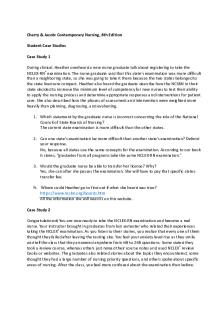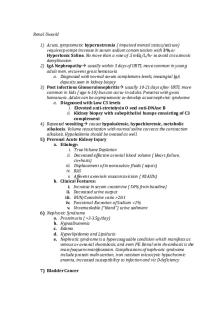Nclex Charts and uworld prep PDF

| Title | Nclex Charts and uworld prep |
|---|---|
| Course | Nursing Concepts III |
| Institution | Louisiana State University |
| Pages | 38 |
| File Size | 346.4 KB |
| File Type | |
| Total Downloads | 19 |
| Total Views | 164 |
Summary
Nclex and uworld prep charts included in the file...
Description
Cerebral Angiography BEFORE 1. Informed consent 2. Explain procedure 3. Lie the patient flat 4. Dye injected into femoral artery. Fluoroscopy & radiologic films taken after injection 5. Procedure Sedation 6. Skin prep; Chosen site shaved 7. Mark peripheral pulses 8. May experience feeling of warmth and metallic taste when dye injected AFTER 1. Neurological assessment every 15-30 minutes until vitals stable 2. Keep flat in bed 12 to 14 hours 3. Check puncture site every hour 4. Immobilize site for 6 to 8 hours 5. Assess distal pulses, color & temperature 6. Observe symptoms of complications (allergic response to dye, puncture site, hematoma) 7. Force fluids 8. Accurate I&O
Lumbar Puncture BEFORE 1. Informed Consent 2. Explain procedure 3. Position patient in lateral recumbent\fetal position at edge of bed
AFTER 1. Neuro checks every 15-30 minutes 2. Position flat for several hours 3. Encourage P.O. fluid to 3,000 mL 4. P.O. analgesics for headache 5. Observe insertion site for bleeding
Urinary Frequency Teaching 1. Empty the bladder frequently (every 2 hours) 2. Drinking at least 2000 mL of fluid per day 3. Limiting fluid intake before bedtime (NOT avoiding fluid intake) 4. Perform kegel exercises to strengthen the perineal muscles 5. Wearing a perineal pad
OB Maternity *May occur in the first trimester and then again late in the third trimester because of pressure placed on the bladder by the enlarged uterus
Potassium Rich Foods • Kiwi • Oranges • Dried Fruit • Bananas • Cantaloupe • Avocados • Broccoli
• Dried Beans/Peas • Lima Beans • Mushrooms • Potatoes • Seaweed • Soybeans • Spinach
Sanguineous • BRIGHT REDÆ Indicates active bleeding Serous • Watery or ClearÆ usually normal Serosanguineous • Pink tinged Æ Indicative of some bleeding Purulent • Yellow/GreenÆ Infection
CVA (Stroke) LEFT CVA • Aphasia (language difficulty) • Alexia (reading difficulty) • Agraphia (writing difficulty) • Right hemiplegia or hemiparesis • Slow, cautious behavior • Depression & quick frustration visual changes, such as hemianopsia *Responsible for language, mathematic skills, & Analytic thinking
RIGHT CVA • Unawareness of deficits • Loss of depth perception • Disorientation • Impulse control difficulty • Poor Judgment • Left hemiplegia OR hemiparesis • Visual changes, such as hemianopsia *Responsible for visual and spatial awareness &proprioception
Phosphate Rich Foods • Fish • Eggs • Milk • Cheese • Large amounts of meat & fish • Whole grains • Carbonated beverages
Cardiac Catheterization BEFORE 1. Informed consent 2. Explain procedure 3. NPO 8-12 hours 4. Empty bladder 5. Check pulse 6. Explain client may experience heart palpitations ; desire to cough when dye injected AFTER 1. Monitor vitals every 15 min for 2 hours. Then every 30 min for 1 hour 2. Check pulses, sensations, and bleeding at insertion site 3. Bed rest 6-8 hours with insertion site extremity straight!
SIADH Early symptoms 1. Headache 2. Muscle cramps 3. Weight gain (no edema: Due to water being retained, NOT sodium) Nursing Interventions 1. Restrict oral fluids 500-1000mL/day 2. Weigh dailyÆ same clothes + same time 3. Report altered LOC [headaches, confusion, lethargy] 4. Take seizure precautions 5. Monitor intake/output accurately 6. Medications: Demeclocycline or Lithium carbonate 7. Monitor Vitals: tachycardia, increased BP, hypothermia 8. Monitor decreased serum sodium + elevated urine sodium osmolality
Heart Failure Teaching Teaching 1. Follow fluid and sodium restrictions 2. Conserve energy Æ schedule REST PERIODS 3. Adhere to medication regimen 4. Weight self daily Æ notify health care provider of weight gain of 2lbs/24 hours OR 5lbs in 1 week* 5. Get influenza vaccine yearly 6. If prescribed Æ DIGOXIN, take pulse for 1 minute. Notify health care provider if pulse is below 60bpm. 7. Take diuretics in early morning and early afternoon 8. Notify health care provider of increased dyspnea, orthopnea, and inability to wear rings or shoes*
Iron Rich Foods • Red meat • Kidney & Lima beans • Egg yolk • Chickpeas • Cooked Swiss chard • Liver • Molasses • Lentils
• Carrots • Raisins • Apricots • Kale • Spinach • Organ Meats • Clams
Blood Transfusion Reactions Circulatory overload *Chest or lumbar pain, cyanosis, dyspnea, moist productive cough, crackles in the lung bases, distended neck veins, increased BP Sepsis *Tachycardia, Fever, abdominal cramps, N/V, diarrhea Allergic + Transfusion Reaction *Flushing, itching, urticarial, tachycardia, low back pain Febrile Reaction *Fever, chills, nausea
Magnesium (1.5-2.5) Below 1.5 = Hypomagnesaemia • • • • • • • •
Arrhythmias Seizures Tetany Muscle weakness Irritability Lethargy Dizziness Confusion
Above 2.5 = Hypermagnesaemia • • • • • • • •
Arrhythmias Muscle weakness and fatigue Nausea/Vomiting Flushing & Sweating Loss of deep tendon reflexes Respiratory depression Hypotension Loss of consciousness
Sodium (135-145) Below 135 = Hyponatremia • Nausea • Seizures • Confusion • Muscle weakness • Headache • Apprehension *Fresh water drowning
Above 145 = Hypernatremia • Lethargy • Neuromuscular excitability • Irritability • Muscle twitching • Weakness • Fever • Increased Blood Pressure • Edema *Heart Failure, Cushing's Syndrome, Diabetes Insipidus
Tyramine Rich Foods • Red wine • Beer • Chocolate • Aged Cheese • Yogurt • Soy Sauce • Sauerkraut (sour cabbage) • Liver • Pizza or Homemade bread • Meats that have been fermented • Figs • Bananas
Peripheral IV Complications Infiltration • Pain on IV site • Cool and pale • Flow of IV Stopped • IV now into subcutaneous tissue Phlebitis • Redness • Pain • Swelling • Inflammation of vein Infection • Fever • Pain at the site
Thrombosis • Presence of a blood clot • Absent pulses below the site of the clot formation Thrombophlebitis • Pain & swelling • Redness • Warmth • Fever • Leukocytosis (Increased WBC) Hematoma • Leak of blood • Bruise • Swelling
Peripheral IV Treatment (Contin.) Treatment 1. Stop the IV 2. Apply warm compress 3. Elevate arm 4. Start IV in new site OR opposite arm *Infiltration, Phlebitis, Infection, Thrombosis, Thrombophlebitis Treatment 1. Discontinue IV 2. Apply pressure 3. Apply cool compress 4. Start IV in new site OR opposite arm *Hematoma
Therapeutic Drug Levels Digoxin: 0.5-2.0 ng/mL Lithium: 0.8-1.5 mEq/mL Dilantin: 10-20 mcg/mL Theophylline: 10-20 mcg/mL
Need to know *** Lab values*** Electrolytes Chemistry Sodium: 135-145 Glucose: 70-110 Potassium: 3.5-5.0 BUN: 7-22 Calcium: 8.5-11 Creatinine: 0.5-1.2 Chloride: 95-105 CPK: 21-232 Magnesium: 1.5-2.5 Urine specific gravity: 1.010Phosphorus : 2.5-4.5 1.030 Bilirubin:...
Similar Free PDFs

Nclex Charts and uworld prep
- 38 Pages

Uworld NCLEX Notes
- 40 Pages

UWorld for Nclex Pharmacology
- 16 Pages

FLOW Charts - assignment prep
- 5 Pages

Nclex PREP PPT Notes
- 9 Pages

Nclex Case Study (prep)
- 3 Pages

Mark klimek notes - NCLEX PREP
- 60 Pages

Nclex 150 QARs Exam Prep No
- 53 Pages

Nclex-RN Prep Study Guide 1
- 7 Pages

Renal Uworld And Thats All
- 6 Pages
Popular Institutions
- Tinajero National High School - Annex
- Politeknik Caltex Riau
- Yokohama City University
- SGT University
- University of Al-Qadisiyah
- Divine Word College of Vigan
- Techniek College Rotterdam
- Universidade de Santiago
- Universiti Teknologi MARA Cawangan Johor Kampus Pasir Gudang
- Poltekkes Kemenkes Yogyakarta
- Baguio City National High School
- Colegio san marcos
- preparatoria uno
- Centro de Bachillerato Tecnológico Industrial y de Servicios No. 107
- Dalian Maritime University
- Quang Trung Secondary School
- Colegio Tecnológico en Informática
- Corporación Regional de Educación Superior
- Grupo CEDVA
- Dar Al Uloom University
- Centro de Estudios Preuniversitarios de la Universidad Nacional de Ingeniería
- 上智大学
- Aakash International School, Nuna Majara
- San Felipe Neri Catholic School
- Kang Chiao International School - New Taipei City
- Misamis Occidental National High School
- Institución Educativa Escuela Normal Juan Ladrilleros
- Kolehiyo ng Pantukan
- Batanes State College
- Instituto Continental
- Sekolah Menengah Kejuruan Kesehatan Kaltara (Tarakan)
- Colegio de La Inmaculada Concepcion - Cebu





